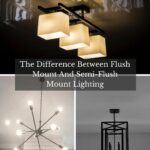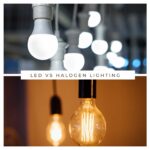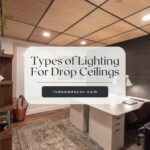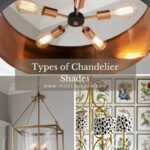The topic of what type of light bulb to use in your home can be a surprisingly complex one. There are seemingly hundreds of factors to consider, so it can be overwhelming!
Since they can impact so many things (including safety!), it’s good to know exactly how LED vs halogen lighting differ from one another, and what that means for you.
In this article, we’ll carry out a full breakdown of two of these most common types of bulbs, how they differ, and which one is best for your circumstances. By the end, we hope you’ll feel a lot more comfortable when choosing lights for your home.
To be more specific, this article will cover:
- What LED and halogen lighting is, and how they differ
- The costs and environmental impact of each
- Respective brightness, color temperature, durability, energy efficiency, and lifespan qualities, and more.
Let’s get straight into it!
What Is Halogen Lighting?
Halogen lighting has been a popular form of lightbulb since their creation in the 50s. They were first introduced as a more energy efficient, brighter type of incandescent bulb, and a first step toward lessened environmental impacts.
In a traditional incandescent bulb, the light is generated by a heated tungsten filament. They work very similarly to a space heater, where current is passed through thin wires until they glow red-hot. This produces both heat and light.
Just like a space heater, this heat and light radiates outward from the wire.
In a bulb, this is then passed through a quartz or glass envelope before being emitted in the space around it to illuminate a room.
Halogen lights are still technically incandescent, but work slightly differently.
This is mostly because of their inclusion of tightly compressed halogen gas inside the bulb that mixes with the tungsten vapor from the filament.
This means that the wire gets even hotter (and brighter), and allows some of the tungsten vapor to be deposited back into the filament for reuse.
This results in a better light bulb in terms of both light and efficiency. Hence, the halogen bulb quickly gained popularity as an alternative to classic incandescents.
What Is LED Lighting?
LED bulbs are completely different to these older forms of lighting.
Rather than relying on something becoming red-hot to produce their light, LEDs make use of something called a diode. This is where their name comes from, after all – they are a Light Emitting Diode!
A diode is made of two different types of semiconductor material. One of these materials is rich in electrons, and the other is covered in holes.
When these semiconductors have a current passed through their meeting point, the two materials combine the electrons with the holes and produce photons. This is what creates the light you see emitting from the bulb.
LEDs have actually been used since the mid 1900s. Until recently, they were only seen in devices like radios, clocks and other electronic displays.
In more recent years, they’ve been reimagined as a revolutionary light source far more efficient and flexible than anything we’ve managed previously.
For this reason, they are quickly becoming the most popular choice in both residential and commercial buildings.
But are they the right choice for you?
LED vs Halogen Lighting: What Are Their Differences?
In this section, we’ll break down every part of these two popular forms of light bulb. Hopefully, this will help you decide which is the best option for your needs.
You should have an idea of your budget, room size, room type, and style preferences while reading. This will help you relate all of these features to your specific case, and figure out which one is the right choice for you!
Types of Bulbs
Bulbs come in a few major forms that apply generally to all types of lighting, including halogen and LED.
Here, we’ll cover a few of the most popular forms. However, this is by no means an exhaustive list. There are a lot of bulbs to choose from out there!
It’s important to choose the right bulb. They will have a huge impact on the spread of light, as well as which fittings are usable. Different bulbs will complement different uses in the home.
Of course, they will also suit different preferences and styles. These are no less important!
Traditional

The most common bulb type is the traditional or GLS bulb. When you think of a lightbulb, you’re almost definitely imagining this kind. It is the traditional, round teardrop shape that you’ll see in any cartoon depiction of a light bulb.
These really haven’t changed much since they were first patented by Thomas Edison in 1897.
Traditional bulbs are suitable for most indoor applications, providing an even spread of light. They work great as wall or ceiling lights but are probably too big for chandeliers or other small fittings.
Spiral

These bulbs were created as an energy-saving method way before LED lights came into the market.
Compared to the classic lights available they are more efficient, but nowhere near the degree that LED lights are. So, once they were outrun by new tech, they quickly faded to semi-obscurity.
The main issue many people have with spiral bulbs is their appearance.
They just aren’t as appealing as many of the more traditional lightbulb forms, having their signature spiral shape along their entire length. This unusual shape is clearly visible when the light is on, which many people don’t like.
Candle

These are decorative bulbs created mainly for use in chandeliers and other grand, traditional-style lights.
They are made to mimic the shape of a candle’s flame, tapering to a soft point at the top.
Most often, they are used in clusters rather than as a lone bulb. You’ll often find them on classic style chandeliers and other similar fittings.
They work wonderfully in traditional and elegant spaces styled after historical inspirations, allowing you to mimic the look and feel of a candelabra while still enjoying the luxuries of modern electric lighting.
Reflector

Also known as spot light bulbs, these are coated with a reflective material that concentrates and directs their light in a single cone.
Reflectors produce little shadow and are mostly seen in spotlights. They are especially popular in outdoor security lights.
G45

Sometimes known as golf ball lights, these are small, round bulbs that (as the name suggests) look a lot like a golf ball on a tee.
Similar to candle bulbs, these are often seen on chandeliers and other multi-bulb light fixtures.
They work great in more modern settings where simple, clean shapes are preferred. They effectively take the place of candle bulbs where a less traditional style is wanted.
G45s are also commonly found in desktop and bedside lamps, since they take up very little space within the fixture.
Downlight

These bulbs sit almost or entirely flush with the ceiling, often with a small rim that sticks out.
They create a strong downward light that’s great for task areas like the kitchen, office or bathroom.
Downlights are also a great choice in spaces with low ceilings, where pendant lights aren’t an option. These are often preferred for ultra-minimalist and modern spaces.
Globe

These lights are bigger than golf ball bulbs, though have the same spherical shape. They are normally used in decorative lights, especially where the bulb is very visible. You may also see them in use without any shade at all, just the bare bulb.
You’ll mostly see these used in pendant and floor lights, since these show off the bulb pretty clearly.
They work great in modern, stylish spaces, especially when paired with other simple, round shapes. Globe lights are a favorite feature of minimalist chandeliers and pendant lights.
Stick

These are fairly similar to spiral bulbs, being brought in as a more efficient alternative to classic incandescent bulbs.
Also like spiral bulbs, they’ve seen a sharp decline in popularity since the arrival of LEDs.
Once again, their pretty unattractive shape makes them an unusual choice when LED bulbs offer most of the same benefits with much greater flexibility of design. You won’t see these in many places anymore.
Environmental Impact
LED bulbs were introduced largely as a way to lessen environmental impacts of lighting across the world. This is one of the main reasons that they’ve surged so much in popularity in recent years.
Unsurprisingly, this means they easily outclass halogen bulbs when it comes to lowering environmental impact.
Halogen bulbs were initially introduced for a similar reason, being a better option than classic incandescent bulbs in terms of energy efficiency.
However, LED bulbs have blown this out of the water! We’ll dive into the exact numbers of this in the energy efficiency section.
Additionally, LED bulbs don’t contain hazardous, environment-damaging materials like mercury.
Halogen bulbs are at risk of releasing these problematic chemicals if disposed of improperly. If you need to get rid of some old halogen bulbs, make sure to research the proper way to do so in your local area.
Unfortunately, they can’t be effectively recycled due to their tungsten filaments.
On the other hand, LED bulbs can be recycled and reused fairly easily. Many places have LED bulb recycling initiatives, or may even accept them at normal recycling plants.
Make sure to call ahead to the plant, though. Don’t just add your bulbs to your normal recycling bin!
Initial Cost
In this category, halogen bulbs are the easy winner.
When purchasing your lights, you’ll soon find that halogen bulbs are a lot cheaper than LED ones. You’ll spend quite a bit less overall buying halogen, especially if you’re purchasing a large number of bulbs at once.
LED lights are more difficult to build and contain more expensive materials. They’re also a popular choice, and manufacturers know it!
All of this leads to LED lights having a much higher price than traditional alternatives.
Long Term Cost
However, it isn’t as simple as only considering the initial cost of the bulbs.
Over time, LED lights will result in a much lower cost to the consumer than halogen equivalents. This is for a few main reasons.
Most importantly, LED lights are far, far more efficient. This means that they consume way less power to produce the same level of light.
Over years, this will save you large amounts of money in electricity bills – enough to pay off the difference in the initial expense fairly quickly.
Additionally, LED bulbs have a much longer lifespan (see the life expectancy section), meaning you’ll spend less money on replacing them. All of these things quickly even out the difference in initial cost between the two bulbs.
Brightness Level

When we talk about the brightness of a light, we measure it in lumens. More lumens mean a brighter light.
Halogen lights have a much more limited range of lumens that they can emit than LEDs. They also emit much fewer lumens per watt of energy consumed.
Specifically, a halogen light will emit about 16-24 lumens per watt, where LED lights will emit 80-100 per watt.
In layman’s terms, this means that, given the same amount of energy, an LED light will be far brighter than a halogen one. For example, a 15 watt LED bulb will match the brightness of an 85 watt halogen bulb.
LED bulbs have a very wide range of brightness levels available. This range includes the entire spectrum of light levels that can be achieved by a halogen light, meaning you can match an LED light to halogen brightness levels if you want.
But how much light do you actually need?
This depends on both the size of your room and its purpose. Your preferences and the specifics of the space will also have an impact on what works best, but there are some generalized rules for lumen levels in a home that will work fine for most cases.
To find out how many lumens your room will need, you’ll first need to calculate its square footage. This is done by multiplying the length of the room by its width.
Once you have this, you can calculate the lumens you need.
For general living spaces like sitting rooms and bedrooms, it’s best to have around 20 lumens per square foot.
In hallways, it can feel overwhelming to have this much light in a tight space. Most people prefer them at around 10 lumens per square foot.
In kitchens and dining rooms, you want enough light to properly see what you’re doing while still keeping things cozy. For this reason, they are normally kept at about 30 to 40 lumens per square foot.
Finally, in bathrooms and working or office spaces you’ll want bright, focused light. This is ideally between 70 and 80 lumens per square foot.
If you have darkly-colored walls, you may want to add an extra 10 lumens to each of these figures. Dark walls will reflect far less light back into the space.
Keep in mind: this amount of light doesn’t need to come from a single light fixture! It should be spread across several bulbs fairly evenly placed throughout the room. This is especially important in large spaces.
Color Temperature
In extremely simplified terms, a light’s temperature is how “white” it looks to us.
We use Kelvins (K) to measure the temperature color of a light. At a higher amount of Kelvins, light seems brighter, with a pure, white tone that makes things feel clean and focused.
With a low number of Kelvins, a light will look dim, warm and orange-toned. This produces a cozy, closed in feeling and can make things a little harder to see.
However, Kelvin doesn’t affect actual brightness. Instead, light that is warmer simply seems dimmer to us, even if it’s producing the exact same number of lumens. This means that lights at a lower temperature color won’t necessarily consume less power.
To give some better context to the Kelvin scale, we can break it into “types” of light.
From 1000 to 2600K the light will look similar to candlelight; fairly dim and very warm. It’s the best way to add a cozy ambience to a room and works wonderfully in table and floor lights.
When you imagine a romantic, candlelit dinner, you probably see this type of lighting.
When we get up to 2600 to 3000K, we have a warm white light. This is the standard color for most residential buildings.
This light is slightly orange and creates an inviting feeling. This means it works excellently in bedrooms, living rooms, dining rooms and as general lighting in the home.
From 3000 to 5000K, we have neutral white lighting. This form of light is vibrant, bright and focused. It’s most often seen in office spaces or other rooms you want to keep professional, well-lit and task-orientated. It’s also used in garages, kitchens, basements and bathrooms.
Finally, at 5000K or above we have bright, white light. This is almost the same Kelvin value as daylight, which sits at 6500K.
It’s sharp and clear, great for areas with very focused, specific tasks. However, it can feel pretty harsh and clinical, especially when paired with white walls. It’s most often seen in display areas, garages, security lighting, study areas and commercial or industrial buildings.
Halogen bulbs naturally burn at around 3000K. This means they emit a neutral white, or slightly warm light depending on the specific model. Old style incandescent bulbs burned at closer to 2700K.
These values can be shifted a bit with filters and materials used in the halogen bulb, but are otherwise set in stone. These lights also tend to shift toward lower color temperatures as they age.
In comparison, LED bulbs can have a wide variety of temperatures. Depending on the specific bulb, they can range anywhere from 1800 to 6500K. This means that they can emulate halogen lights if you want, or do pretty much anything else.
Make sure to pay attention to the Kelvin value of the bulbs you’re considering. It has a major impact on the room they’re in, effectively setting the mood of the space.Never underestimate the role of lighting in creating the right feel in a room!
Durability
Halogen bulbs are known for their fragility – one of their major downsides.
When installing halogen bulbs you’ll need to make sure to wear gloves. This isn’t for your protection, but for theirs.
Halogen bulbs are made of materials that react strongly with the oil on our skin. Getting your hands in direct contact with the bulb can lead to it malfunctioning, not working at all, or outright bursting! This not only ruins the bulb, but can be dangerous.
Once installed, halogen bulbs continue to be pretty fragile. They have a brittle filament and wire inside that are vulnerable to being damaged by vibrations or strong impacts against the bulb.
If either of these things break, the bulb won’t function.
A major culprit for damaging halogen bulbs in this way are nearby machinery or fans that cause consistent, frequent vibrations that wear the components down over time.
Additionally, halogen bulbs do poorly in cold weather. Being exposed to cold temperatures repeatedly may cause a halogen bulb to have a shorter lifespan.
It should also be noted that if cold water splashes directly onto a hot halogen bulb (such as from rain or snow), it’s likely to shatter.
In comparison, LED bulbs are surprisingly hardy.
Most are constructed of shatterproof plastic, meaning they won’t break easily even with a direct hit. Additionally, they have no delicate interior parts, meaning they are normally unaffected by vibrations or impacts.
LEDs don’t require any special techniques or safety gear to install, and normally just involves screwing straight into the fixture.
Another plus is that LED lights are mostly unaffected by cold temperatures. They burn at a much colder temperature than halogen, meaning cold weather shouldn’t lower their lifespan by any significant amount.
Overall, LED bulbs are much more likely to survive being dropped, hit, or otherwise impacted by the environment around them.
This means they’re much more likely to reach the end of their expected lifespan without issue. They’re also much less hazardous to nearby people if they do break.
This is especially useful in lights that are in easy reach of people, like floor or tabletop lamps.
These are at much higher risk of being bumped, hit or knocked to the ground. Using LED bulbs means you can worry less about this resulting in an expensive replacement or even injury.
Energy Efficiency

Halogen lights were first introduced as an energy efficient alternative to classic incandescent bulbs. However, when LED bulbs arrived, they blew halogens out of the water!
This is the biggest selling point of LED bulbs for most people.
When we talk about energy usage in lightbulbs, we do so using the unit lumens per watt. This is the ratio between the light produced by the bulb and the energy it consumed to do so.
It’s measured by finding how much light is produced when the bulb is provided with a single watt of energy.
A common wattage for a halogen bulb is 100 watts. These will produce around 1,750 lumens of visible light, giving them a watt per lumen value of 17.5.
In comparison, a common 15 watt LED bulb would produce around 1,400 lumens of light. This gives it a watt per lumen value of 93.
LED bulbs use far, far less energy than halogen bulbs. Specifically, they use around 85% less at their best performance. This means you spend way less on electricity for the same, or better, result.
In some states, incandescent and halogen lights aren’t even allowed to be sold because they no longer meet the local codes for energy efficiency.
Life Expectancy
This section refers to how long a bulb can go before it needs replacing.
The average halogen light has a lifespan of 2,000 hours of illumination. If we assume the light is on for 4 hours each day, this means they will last about 2 to 3 years before needing replacement.
A normal LED bulb will last for around 25,000 hours. Assuming the same 4 hours of use a day, you’ll need to replace the bulb after 15 years. This makes the LEDs lifespan about 6 times longer than a halogen bulb.
Additionally, LED lights are much less affected by repeatedly being turned on and off. In comparison, halogen lights can have their lifespan severely shortened by frequent power cycling.
Their longer lifespan makes LEDs a great choice for recessed or very high up lights, where changing bulbs can be a huge pain.
Changing the bulb less often also means financial savings, since you won’t need to buy more lights as frequently.
Safety
This is something you should definitely consider when choosing a bulb.
The main safety concern with halogen bulbs centers around their temperature during use.
Because halogen bulbs function by making a thin wire red-hot – thus producing a glow – they require a lot of heat to work. Their heat production is even higher than traditional incandescents, thanks to the halogen gas in the bulb.
This is a major risk if you try to change the bulb after recently turning it off. The bulb of a halogen light stays extremely hot for a while after being turned off – definitely hot enough to burn your hands if you make contact with it!
If you need to touch a halogen bulb, make sure to wait long enough for it to cool down completely.
Additionally, this heat can be a fire hazard. Halogen lights and their transformers produce enough heat to ignite materials like fabric, paper, dust and insulation batts if they get too close.
If these things come into contact with the bulb, it can result in a house fire.This is an even greater risk if the lights haven’t been installed correctly!
If you have a halogen light, especially if it’s a floor or table lamp that’s easily in reach, make sure to be constantly aware of this.
Never lay clothes or any other flammable items over a lamp, or place the light close to things like curtains.
LED lights produce some heat, but it’s to an almost negligible level. You should still be careful when handling bulbs that were recently turned off, but you’re very unlikely to be burned by an LED light – even right after it’s been turned off.
This also means LED lights are highly unlikely to start a fire, even if it’s in direct contact with flammable materials. We still recommend keeping these things away from lights though, just in case!
Also notable is the fact that halogen bulbs can release toxic substances like mercury if broken. On the other hand, LED lights have no immediately dangerous materials inside.
Additionally, because LED lights are made of plastic, they won’t send glass shards flying everywhere if broken.
This is something you should be careful of with halogen bulbs. Broken glass on the ground is especially dangerous to children and pets.
If broken, the plastic of an LED bulb can still be sharp. Therefore you should still be careful, but it’s much less hazardous than glass.
Dimming Capability

Both LED and halogen lights can be dimmable. However, not all bulbs have this feature.
To have dimmable lighting, you need a dimmable bulb and a compatible light switch. Just because a bulb is dimmable doesn’t mean it will work with any light switch with a dimmer dial, however.
Make sure that the bulb and switch are compatible by checking their information sheets and packaging. If you’re still not sure, you can also contact the manufacturer of the components to ask since they’ll have most accurate information.
Some LED bulbs now come with an app on your phone that allows you to change their color, dim them and toggle them off and on.
This is extra convenient, letting you control your lights from anywhere with a single tap.
It also makes for an easy way to experiment with different lighting in the same space. They even allow you to change their temperature and brightness on a whim rather than having to commit to these things when you first buy the bulb.
Compatibility
If you’re considering replacing your halogen bulbs with LED ones, there are a few options.
It is possible to add LED bulbs to existing fixtures that previously held halogen lights. However, you need to make sure that the fixture’s voltage matches the new light.
If a fixture has a low voltage halogen bulb it will also have a transformer. This means that you need to find the operating voltage of the transformer and make sure your LED light matches. These are normally either 12V or 24V.
You should also check the rim of the light, most often measured in millimeters.
Sometimes, the Edison code is used to describe the size of a light or fitting. This has an E, followed by the mm diameter of the fixture or bulb. For example, the most common types are E26 and E27, which have 26mm and 27mm bases respectively.
E bases are for single contact bulbs. Double contact bulbs will require a double contact base. You should also look out for this when matching bulbs to existing fixtures.
Your other option when switching halogen lights for LEDs is a full reinstall of new fixtures to match the new lights. This is pricier, but is sometimes the only option. Certain fixtures won’t allow for proper retrofitting.
This also gives you much better control over the final look of your space.
To figure out which option is best for you, it may be necessary to hire an expert electrician to evaluate your fittings. If in doubt, it’s better to pay for an expert’s advice than wing it and find you’ve done it all wrong – especially when working with electricity!
Ultraviolet And Infrared Light
These waveforms of light are produced by halogen bulbs in fair amounts. They aren’t hazardous to people, but can be very damaging to the surface of fabric and artworks.
This can be especially distressing if expensive or rare artwork is damaged.
To avoid this, halogen lights can be fitted with a quartz or glass filter to prevent the photons from damaging the item.
Alternatively, LED lights can be used. These produce pretty much negligible amounts of ultraviolet and infrared radiation, meaning they won’t damage fabric or artwork.
However, if infrared light is desired, such as for certain devices like night vision goggles, LEDs can be configured to emit it at higher levels. We see this most often in remotes for TVs and other electronics.
Extra Note
Please always keep in mind that installing electronic devices will carry a danger of electrocution if proper protocols aren’t followed.
Make sure to follow all safety guideline!
If in doubt, it’s better to pay for an expert than get hurt. If you aren’t sure how to handle electrical devices safely, hire a licensed electrician to do it for you. This will ensure your safety, and a professional-level result at the end.
The Verdict
Now that we’ve broken down the many differences between LED and halogen bulbs, we hope the two are more clearly defined for you!
There are a lot of things to consider when deciding between them.
The most important things to keep in mind are the size of your room, your budget, and your preference in style.
Ultimately, we all have different senses of style. Rules of interior design are what work for most people, but don’t let them constrain you too strongly if you feel differently.
If you can afford the initial investment, our judgment is that LED lights are far more efficient, effective and flexible in terms of light type and style.
However, everyone’s situation is different, which is why we wrote this article! Hopefully, we’ve helped you understand this topic a bit more and decide for yourself which type of light is the best option for you.
Good luck and happy decorating!







